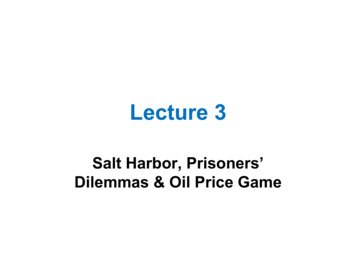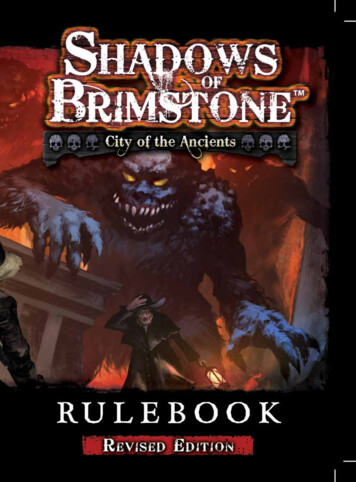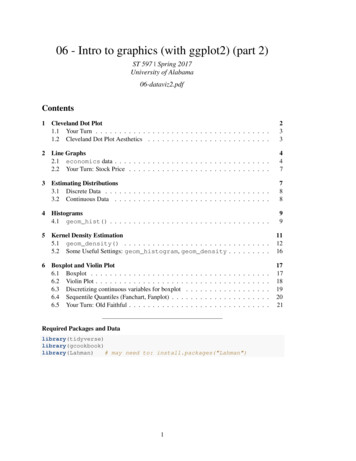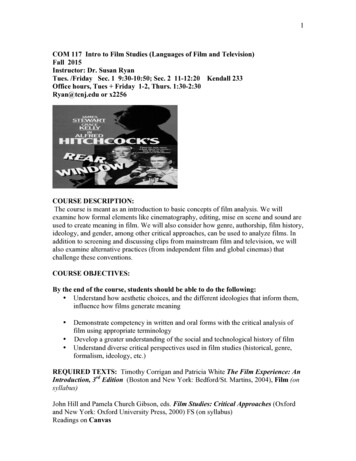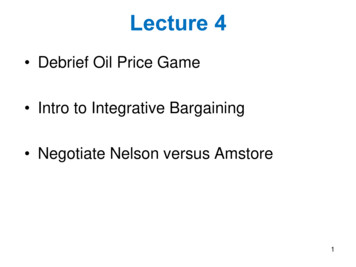
Transcription
Lecture 4 Debrief Oil Price Game Intro to Integrative Bargaining Negotiate Nelson versus Amstore1
Nelson vs. Amstore Forms Please fill in your responses to:– The KUHLMAN AND MARSHELLOMOTIVATIONAL STYLE ASSESSMENT FORMand the- Amstore vs. Nelson RECORD FORM2
Pick up confidential information foryour role in the Jessie Jumpshotnegotiation– Jessie Jumpshot– Boston Sharks Manager– Jessie’s AgentWe will negotiate in the next class meeting3
TODAY’s THEMES Oil Price Game– The central role of TRUST! Win-Win!– What it is, What it is NOT Power & Persuasion– Key Information– Interests versus Positions Negotiation tactics – Relative Importance– Indifferent packages4
Oil Price Game
Trust in Negotiation Rendering oneself vulnerable withthe expectation that your counterpartwill not take undue advantage andwill reciprocate with an offer thatbenefits both of you.
TRUST TAXONOMY- Thompson Table 6-2TRUSTPersonalBusinessDeterrenceBased Lack of Trust Prenuptial SurveillanceKnowledgeBased Sympathyfor the other Theory X Threats, Threats,sanctions punishments,sanctionspunishments Surveillance Understand, Assessment ofclients’ needsappreciate CustomerpartnersdrivenfocusIdentificatio True empathyfor the othernBasedEmbedded Empathy Theory Y Employees fit in Developcorporate culture, social identityshare values7
How does Mistrust Arise? Breach or defection Miscommunication Dispositional Attribution– Calling into question another person’sintentions or character as a device forattributing cause to an incident or behaviorThompson Ch. 6
Reciprocity “ we feel obligated to return in kind whatothers have offered or given to us.”Thompson Ch. 6 p. 134
Reciprocity My concessions met with concessions onyour part I share information expecting that you willtoo What I say is truthful and subject tovalidation10
Reputation “Negotiators act much tougher whendealing with someone who has thereputation of being a liar– Tough or manipulative tactics are mostoften used in a defensive fashion with liarsand tough negotiators– Or in an opportunistic fashion with“creampuffs”Thompson Ch. 6 p 141
Building Trust TRANSFORM personal conflict to taskconflict AGREE on common goal, shared vision CAPITALIZE on network connections FIND shared problems, shared enemies FOCUS on the future!12
Repairing Broken TrustThompson Ch. 6 Box 6-2 Suggest Personal Meeting Focus on Positive Relationship Apologize Let other side vent Don’t get defensive13
Ask for clarifying information Test your understanding of the otherside Discuss ways to avoid future problems Get feedback with relationship“checkup”14
Win-Win!Expanding the Pie to be cut15
What is Win Win? It is NOT:– Compromise– Even Split– Feeling Good– Building a relationship16
Win Win A negotiation in which– ALL creative opportunities are surfaced andexploited– NO resources or payoffs available tonegotiating parties are left on the table17
Win-Win PotentialDo parties have different– Valuations across issues?– Probability beliefs?– Risk Preferences?– Time Preferences?18
Pyramid ModelLevel III: ParetoOptimal AgreementLevel II: Better for BOTH than someother feasible negotiable agreementsLevel I: Agreement exceeds BATNAs or RPs19
Is Level 3 Easy? Sounds easy but Hundred of negotiationsimulations with executives reveals that:– Fewer than 25% reach Pareto Optimalagreements– Approximately 50% of those who do, do so bychance!– “This data is based on executives’ performance innegotiation simulations that involve (integrative) winwin potential” Thompson p7320
Strategies That Don’t ReallyWork Commitment to a Win-Win Deal– No guarantee– False sense of security Compromise– Agreeing to equal concessions or “splitting thedifference” can block expanding the pie– Focus is then on slicing not expanding the pie21
Focus on Long term Relationships– Absolutely key in some settings– BUT this does not directly translate intoWin-Win in a current negotiation– It does often smooth the path Cooperative Orientation– Nice BUT– Don’t let this detract from focus oneliciting/sharing the right information at theright time– Pruitt and Carnevale (1993) Dual Concern Concern for both other party & own interests22
What DOES Work?23
While SHARING information– Police yourself against the illusion oftransparency You believe you reveal more than you reallyare You believe others have access to informationabout you that they don’t Avoid Haggling– Avoid haggling over a single issue—a tug of war!– This lures you into compromise agreements24
Positions vs Interests Distinguish Positions fromInterests or Priorities– Position Stated Demand– Interests Relative Priorities of issues25
Make Multiple OffersSimultaneously Devise multiple issue offers Structure these offers so that they are ofequal value to you! Make them all at one time26
Why? Avoids sequential ‘split the pie’ bargaining Often works with an uncooperativecounterpart Helps avoid substantiation:– Arguments in favor of one’s position oragainst your counterpart that interfere withWin-Win27
Gains better information– Allows parties to exchange information andunilaterally deduce counterpart’s true interestsand where joint gains lie More persuasive Signals priorities more effectively28
Overcomes concession aversion– If your counterpart perceives that she hasmore choices—as opposed to only one—shemay be more likely to comply29
Contingency Contracts Create Value by Building on Differences in:– Valuations– Probabilities– Time preferences– Risk attitudes Contingency Contracts must be:– Enforceable– Clear, measurable and readily evaluated30
CLAIMING Do not forget about CLAIMING!– Just expanding the pie is not an effectivestrategy– You must also be prepared to claim31
MetamorphosisOld Fashioned negotiator Flower Child negotiator Enlightened negotiator32
Opening Gambits and UsefulTactics33
Which do you Prefer and Why? First Gambit:– Open by asking for a lot on issues that areimportant to you– Hold the fort! Don’t give in– Don’t immediately reveal the relativeimportance of issues to you– Modify the pot with issues that are not veryimportant to you to keep the negotiation going– But do this slowly34
Second Gambit:– Introduce less important issues first and offerearly concessions on these issues as a lever to:– Try to discover the relative importance ofissues to your counterpart before establishing apublic position on issues that are important toyou– Give some, not all information on which issuesare really important to you– Then insist on a “fair deal” on your importantissues35
Developing a NegotiationStyleThompson Chapter 5 –Nice Discussion!36
Does Style “Tough” vs “Soft”? TOUGH– “Unflinching, makes high, concedes little,holds out until the very end, and often rejectsoffers within the bargaining zone” SOFT– “Offers too many concessions, reveals his orher reservation point, and is so concerned thatthe other party feels good about the negotiationthat he or she gives away too much of thebargaining pie.”Thompson Ch. 5 pp. 96-9737
MOTIVATIONAL STYLESA Broad TaxonomySee Thompson Ch. 5 pp 9938
INDIVIDUALISTIC Her /His Objective SELF-INTEREST View of others Theyare also SELF-INTERESTED Situations that trigger this orientation externalincentives toMAXIMIZE OWN GAINS39
COMPETITIVE Her /His Objective VICTORY! View of others Theyare COMPETITIVE Situations that trigger this orientation GROUPCOMPETITION:Interpersonal Comparisons are Salient40
COOPERATIVE Her /His Objective JOINT WELFARE View of others SOME COOPERATIVE, SOMECOMPETITIVE, SOMEINDIVIDUALISTIC Situations that trigger this orientation SocialIdentity & External Goals41
Thumbnail Summary INDIVIDUALISTIC– Maximize one’s own gain. Indifferent to howmuch one’s counterpart gets COMPETITIVE– “Beat the other side” by maximizing thedifference between one’s own profits and thoseof your counterpart COOPERATIVE– Seeks to minimize outcome differencesThompson Ch. 5 page -99-42
Assess YOUR Style!Motivational Style Assessment TestKuhlman & Marshello (1975)J RES PERSONALITY Vol. 9 240-251Cited in Thompson Ch 5 Exhibit 5-4 p 10043
Nelson ContractingIssues and Comments44
Issues to Negotiate Price Design Type Targeted Completion Time Installation45
Objectives Maximize your payoff as measured in points Do so in a fashion that engenders respectfrom your negotiating partner– Does she want to negotiate again with you?46
Relative Importance How do you discover the “importance” ofan issue to you relative to all others? How do you discover the “importance” ofan issue to your negotiating counterpartrelative to all others?47
Experiment with MultipleOffers Discover counterpart’s ordinal ordering ofpreferences by putting two or more offerson the table Structure these offers so that you areindifferent among them!48
MIT OpenCourseWarehttp://ocw.mit.edu15.067 Competitive Decision-Making and NegotiationSpring 2011For information about citing these materials or our Terms of Use, visit: http://ocw.mit.edu/terms.
MOTIVATIONAL STYLE ASSESSMENT FORM . and the - Amstore vs. Nelson RECORD FORM . 2 Pick up confidential information for your role in the Jessie Jumpshot negotiation –Jessie Jumpshot –Boston Sharks Manager –Jessie’s Agent We will negotiate in th


